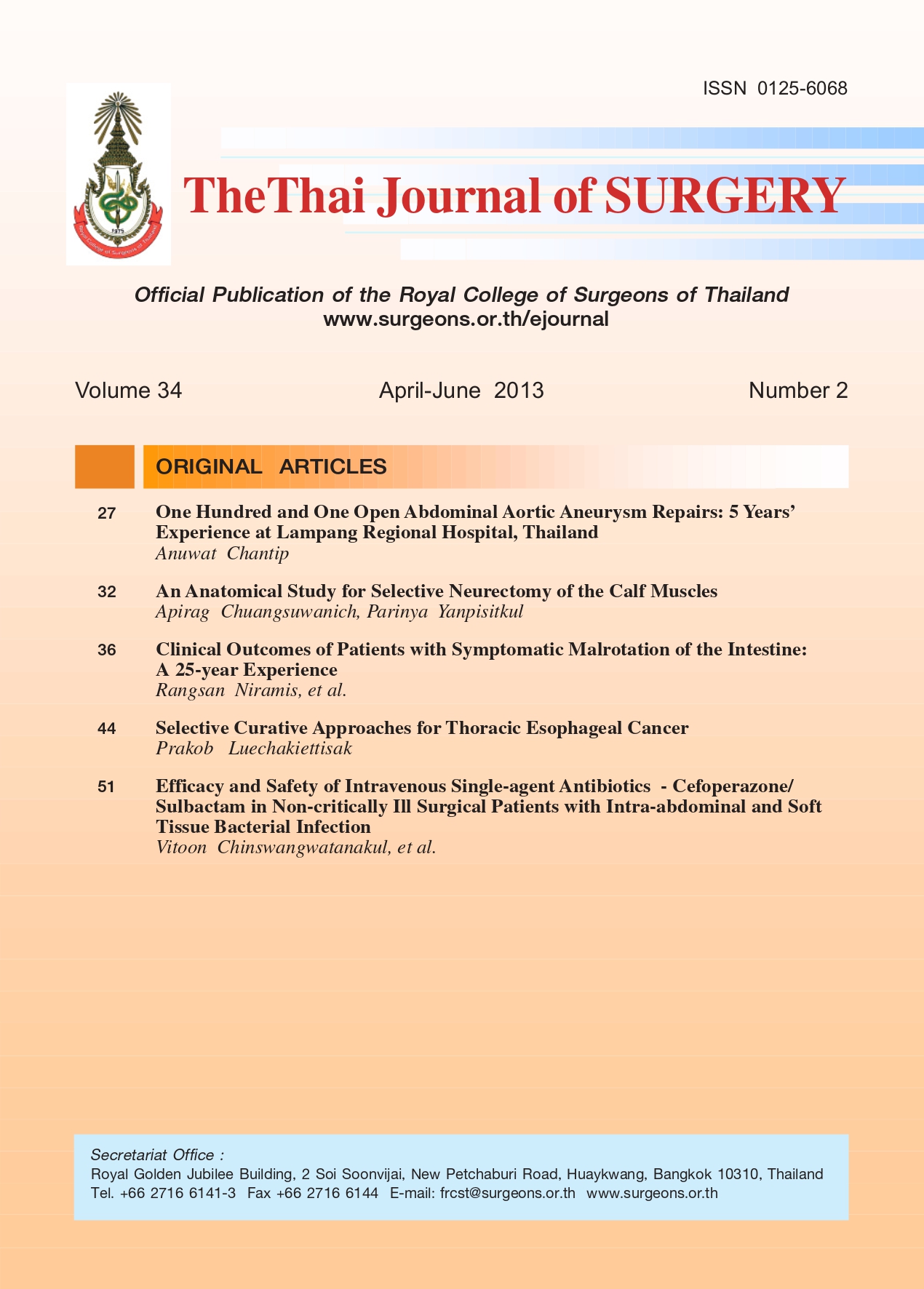Efficacy and Safety of Intravenous Single-agent Antibiotics - Cefoperazone/ Sulbactam in Non-critically Ill Surgical Patients with Intra-abdominal and Soft Tissue Bacterial Infection
Keywords:
Antibiotics, monotherapy, surgical infection, intra-abdominal infection, skin and soft tissue infectionAbstract
Purpose: To evaluate the efficacy and safety of intravenous single-agent antibiotic Cefoperazone/Sulbactamfor the treatment of bacterial infection among surgical patients.
Methods: This prospective opened non-comparative clinical trial was conducted in the Department of
Surgery, Faculty of Medicine Siriraj Hospital, Bangkok, Thailand from 1October 2008 to 30 September 2009.
Therapeutic Cefoperazone/Sulbactam (Sulcef®) at the dose of 1.5 grams was given intravenously every 12 hours to
patients with bacterial infection who needed emergency or elective surgical interventions, and the APACHE II score
was equal or less than 15. All patients were scheduled for follow-up visits at 7, 14 and 30 days after the first dose of
intravenous Cefoperazone/Sulbactam for monitoring the clinical outcomes.
Results: Thirty-five patients were enrolled and 31 patients had completed the follow up. There were 17 males
and 14 females with the mean age of 53 years (range 20-85 years). The clinical efficacy of Cefoperazone/Sulbactam
to improve or cure patients was 87%, whereas the bacterial eradication rate was 84%. Neither drug-related serious
adverse reaction nor drug allergy was observed.
Conclusions: Cefoperazone/Sulbactam demonstrated broad-spectrum antibacterial coverage in patients
infected with gram-positive, gram-negative and anaerobic bacteria. Intravenous Cefoperazone/Sulbactam is safe
and effective for empirical treatment of bacterial infection among surgical patients.
References
an advisory Statement from the National Surgical Infection
Prevention Project. Clin Infect Dis 2004;38:1707-15.
2. Buchi W, Casey PA. Experience with parenteral and
sequential parenteral-oral Cefoperazone/Sulbactam in
hospitalized patients. Infection 1988;16:306-12.
3. Lohsiriwat D, Chinswangwatanakul V, Lohsiriwat V,
Leelaratsamee A. Efficacy and safety of parenteral
amoxicillin/clavulanate for prevention of surgical site
infection following abdominal surgery. J Med Assoc Thai
2009;92:1167-70.
4. Obwegeser J, Kunz J, Schar G, Steiner R, Buchi W. Clinical
efficacy of Cefoperazone/Sulbactam in laparoscopically
confirmed salphingitis. J Antimicrob Chemother 1989;24:165-
76.
5. Horan TC, Gaynes RP, Martone WJ, Jarvis WR, Emori TG. CDC
Definitions of nosocomial surgical site infections, 1992: A
modification of CDC definitions of surgical wound infections.
Infect Control Hosp Epidemiol 1992;13:606-8.
6. Auerbach AD. Prevention of surgical site infections. In:
Shojania KG, Duncan BW, McDonaold KM, et al., Making
health care safer: a critical analysis of patient safety
practices. Evidence report/technology assessment no. 43.
AHRQ publication no. 01-E058. Rockville, MD: Agency for
Healthcare Research and Quality, 20 July 2001;221:44.
7. Perencevich EN, Sands KE, Cosgrove SE, Guadagnoli E,
Meara E, Platt R. Health and economic inpact of surgical
sites infections diagnosed after hospital discharge. Emerg
Infect Dis 2003;9:196-203.
8. Robinson JL, Hameed T, Car S. Practical aspects of choosing
an antibiotic for patients with a reported allergy to an
antibiotic. Clin Infect Dis 2002;35:26-31.
9. Williams JD. Beta-lactam inhibition and in vitro activity of
sulbactam and Sulbactam/cefoperazone. Clin Infect Dis
1997;24:497-507.
10. Lee N, Yung KY, Kumana CR. Clinical role fo beta-lactam/
beta-lactamase inhibitor combinations. Drugs 2003;63:1511-
24.
11. Wexler HM, Finegold SM. In vitro of cefoperazone plus
sulbactam compared with that of other antimicrobial agent
against anaerobic bacteria. Antimicrob Agents Chemother
1988;32:403-6.
12. Clark RB, Bartelt MA, Chan BL, Dalton HP. Multicentre study
on antibiotic susceptibilities of anaerobic bacteria to
cefoperazone-sulbactam and other antimicrobial agent. J
Antimicrob Chemother 1992;29:57-67.
13. Jia-tia L, Yuan L, Jie H, Yi-fang C, Jing-zhi M, Yu-xia J. Sulbactam/
cefoperazone versus cefotaxime for the treatment of
modurate-to-severe bacterial infections: results of a
randomize, controlled clinical trial. Clin Infect Dis 1997;24:498-
505.
14. Engin A, Mentes B, Turet S. Clinical experience with
sulbactam/cefoperazone in critical surgical infections. Curr
Ther Res Clin Exp 1991;49:989-97.
15. Jauregui LE, Appelbaum PC, Fabian TC, Hageage G,
Strausbuagh, Martin LF. A randomized clinical study of
cefoperazone and sulbactam versus gentamicin and
clindamycin in the treatment of intra-abdominal infections.
J Antimicrob Chemother 1990;25:423-33.
Downloads
Published
How to Cite
Issue
Section
License
Articles must be contributed solely to The Thai Journal of Surgery and when published become the property of the Royal College of Surgeons of Thailand. The Royal College of Surgeons of Thailand reserves copyright on all published materials and such materials may not be reproduced in any form without the written permission.



